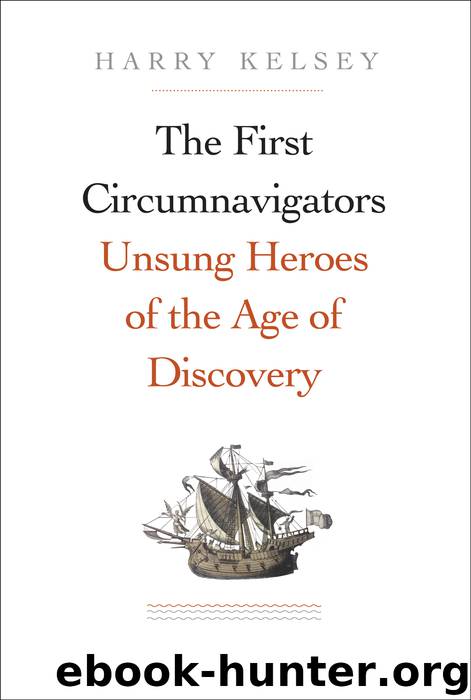The First Circumnavigators by Harry Kelsey

Author:Harry Kelsey
Language: eng
Format: epub
Publisher: Yale University Press
Published: 2016-08-06T16:00:00+00:00
FIVE
Following the Leader
Once the return route was established by Father Urdaneta, it was no longer necessary for mariners and explorers to risk the treacherous seas and storms of the globe-circling route used by the Spanish commanders. Even so, two English sea captains followed their lead in crossing the Pacific from east to west and sailing home around the Cape of Good Hope.
Francis Drake
The first was Francis Drake, whose fleet looted and burned its way around the world in a three-year voyage that started in November 1577. Sailing off with five vessels and a crew of about 180 men and boys, Drake’s ships were scarcely out of Plymouth, England, when a sudden squall drove the vessels into harbor at Falmouth in Cornwall. There the ships were sorely beaten by wind and waves and forced to return to Plymouth for refitting.1
They sailed once more in mid-December, following Magellan’s route along the coast of Africa, past the Canary Islands and to the Cape Verde Islands. Along the way they captured several Portuguese caravels, as well as a forty-ton fishing smack, which Drake exchanged for a fifteen-ton vessel from his own fleet. If any of the seamen had entertained doubts about the piratical nature of the voyage, all was now clear.2
This was only the beginning. Near the island of São Tiago he captured a Portuguese merchant vessel, the Santa Maria, loaded with wine and other goods. The captain, Nuño de Silva, was an experienced pilot who knew the coast of South America. He was placed aboard Drake’s ship, while his partner, Thomas Doughty, was assigned to command the Portuguese ship. There was soon trouble. Doughty argued with Drake’s brother, also named Thomas. In the end, Drake took command of the wine-laden Santa Maria, while Doughty took Drake’s ship, the Pelican.3
Relations between the two men continued to deteriorate, and in June 1578, when the fleet reached winter quarters at Puerto San Julián, Doughty was charged with several crimes, of which mutiny was perhaps the least serious. In a strange replay of Magellan’s actions at San Julián more than half a century earlier, Drake had Doughty tried, convicted, and decapitated.4 Was it a deliberate attempt to copy his predecessor? As Nuño de Silva noted, Drake “brought with him his three books of navigation, one in French, another in English, and the other was the discovery of Magellan, I don’t know in what language.”5
Thus equipped, Drake sailed through the Strait of Magellan and by the end of October reached the Pacific Ocean. Of the 180 who began the trip, at least 50 had deserted and others perished from hostilities, executions, hunger, and disease. The only ship left was the Pelican, which may have been rechristened the Golden Hinde during the voyage through the strait.6
Drake soon had a fleet again. Sailing boldly into the harbor at Valparaiso early in December 1578, he captured a ship called La Capitana, which had been the flagship of Pedro Sarmiento de Gamboa a decade earlier. Suddenly he had a second ship, a fleet, and riches; perhaps two hundred thousand pesos in gold.
Download
This site does not store any files on its server. We only index and link to content provided by other sites. Please contact the content providers to delete copyright contents if any and email us, we'll remove relevant links or contents immediately.
| France | Germany |
| Great Britain | Greece |
| Italy | Rome |
| Russia | Spain & Portugal |
Fanny Burney by Claire Harman(25778)
Empire of the Sikhs by Patwant Singh(22163)
Out of India by Michael Foss(16309)
Leonardo da Vinci by Walter Isaacson(11896)
Small Great Things by Jodi Picoult(6086)
The Six Wives Of Henry VIII (WOMEN IN HISTORY) by Fraser Antonia(4784)
The Wind in My Hair by Masih Alinejad(4420)
The Lonely City by Olivia Laing(4112)
The Crown by Robert Lacey(4099)
A Higher Loyalty: Truth, Lies, and Leadership by James Comey(4025)
The Iron Duke by The Iron Duke(3636)
Millionaire: The Philanderer, Gambler, and Duelist Who Invented Modern Finance by Janet Gleeson(3565)
Sticky Fingers by Joe Hagan(3449)
Alive: The Story of the Andes Survivors by Piers Paul Read(3303)
Papillon (English) by Henri Charrière(3264)
Joan of Arc by Mary Gordon(3253)
Stalin by Stephen Kotkin(3081)
Aleister Crowley: The Biography by Tobias Churton(3015)
Ants Among Elephants by Sujatha Gidla(2920)
